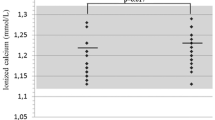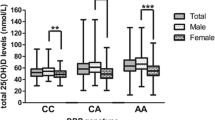Abstract
Patients with osteoporosis have a low bone mass resulting in an increased risk for bone fractures, morbidity and mortality. One hundred thirty-one female pre-menopausal participants (98 Turkish immigrants living in Germany in comparison with 33 age-matched healthy Germans) were recruited for this study which explored vitamin D deficiency and specific genetic modifications of bone metabolism. The subjects were investigated for their femoral and lumbar bone mineral density (BMD) by dual-energy X-ray absorptiometry (DEXA) of the right total femur and the lumbar spine. Serum levels of osteologic parameters were determined: parathormone (PTH), calcium (Ca), osteocalcin (OC), phosphate (P), alkaline phosphatase (AP), beta-crossLaps (CL), tartrate-resistant acid phosphatase isoform 5b (TRAP5b), and 25-vitamin D3 (25-OH D3). The Bsml- and Fokl-polymorphisms of the vitamin D receptor (VDR) gene and the collagen type I alpha 1 (COLIA1)-gene polymorphism were also genotyped. An extremely high prevalence of vitamin D deficiency could be found in the immigrant cohort (87.8 %). Osteoporosis but not osteopenia was more prevalent in this group. Among immigrants with osteoporosis, TRAP5b was elevated in 42.9 % and beta-CL in 28.6 %. Only the Fokl FF-genotype of the VDR polymorphism was significantly more prevalent among the Turkish women, Ff-genotyped immigrants showed significantly decreased BMD. A significant correlation between the COLIA1-gene polymorphism and BMD could not be identified in the two groups. Vitamin D deficiency and osteoporosis appear to be dominant and unrecognized problem among female Turkish immigrants in Germany. Therefore, in this population, osteologic parameters and BMD should be routinely analyzed and deficiencies be treated immediately.
Similar content being viewed by others
References
Haussler MR, Whitfield GK, Haussler CA, Hsieh JC, Thompson PD, Selznick SH, Dominguez CE, Jurutka PW (1998) The nuclear vitamin D receptor: biological and molecular regulatory properties revealed. J Bone Miner Res 13:325–349
Uitterlinden AG, Fang Y, Van Meurs JB, Pols HA, van Leeuwen JP (2004) Genetics and biology of vitamin D receptor polymorphisms. Gene 338:143–156
Slattery ML (2007) Vitamin D receptor gene (VDR) associations with cancer. Nutrition Rev 65:S102–104
Holick MF (2004) Vitamin D: importance in the prevalence of cancer, type 1 diabetes, heart disease and osteoporosis. Am J Clin Nutr 79:363–371
Meyer HE, Falch JA, Sogaard AJ, Haug E (2004) Vitamin D deficiency and secondary hyperthyreoidism and the association with bone mineral density in persons with Pakistani and Norwegian background living in Oslo, Norway. The Oslo Health Study. Bone 35:412–417
Norman AW (2008) From vitamin D to hormone D: fundamentals of the vitamin D endocrine system essential for good health. Am J Clin Nutr 88:491–499
Labuda M, Fujiwara TM, Ross MV, Morgan K, Garcia-Heras J, Ledbetter DH, Hughes MR, Glorieux FH (1992) Two hereditary defects related to vitamin D metabolism map to the same region of chromosome 12q13-14. J Bone Miner Res 7:1447–1453
Davis CD (2008) Vitamin D and cancer: current dilemmas and future research needs. Am J Clin Nutr 88:565–569
Morrison NA, Qi JC, Tokita A, Kelly PJ, Crofts L, Nguyen TV, Sambrook PN, Eisman JA (1994) Prediction of bone density from vitamin D receptor alleles. Nature 367:284–287
Hustmeyer FG, Peacock M, Hui S, Johnston SS, Christian J (1994) Bone mineral density in relation to polymorphism at the vitamin D receptor gene locus. J Clin Invest 94:2130–2134
Gross C, Eccleshall TR, Mallory PJ, Villa ML, Marcus R, Feldmann D (1996) The presence of a polymorphism at the translation initiation site of the vitamin D receptor gene is associated with low bone mineral density in postmenopausal Mexican-American women. J Bone Miner Res 11:1850–1855
Bartley J (2008) Prevalence of vitamin D deficiency among patients attending a multidisciplinary tertiary pain clinic. N Z Med J 121:57–62
Lips P (2007) Vitamin D status and nutrition in Europe and Asia. J Steroid Biochem Mol Biol 103:620–625
Erkal MZ, Wilde J, Bilgin Y, Akinci A, Demir E, Bödecker RH, Mann M, Bretzel RG, Stracke H, Holick MF (2006) High prevalence of vitamin D deficiency, secondary hyperparathyreoidism and generalized bone pain in Turkish immigrants in Germany: identification of risk factors. Osteoporos Int 17:1113–1140
Francis RM, Selby PL (1997) Osteomalacia. Baillieres Clin Endocrinol Metab 11:145–163
Solomon E, Hiorns L, Sheer D, Rowe D (1984) Confirmation that the type I collagen gene on chromosome 17 is COL1A1 (alpha 1(I), using a human genomic probe. Ann Hum Genet 48:39–42
Grant SFA, Reid DM, Blake G, Herd R, Fogelman I, Ralston SH (1996) Reduced bone density and osteoporosis associated with a polymorphic Sp1 binding site in the collagen type a1 gene. Nat Genet 14:203–205
Langdahl BL, Ralston SH, Grant SFA, Eriksen EF (1998) An Sp1 binding site polymorphism in the COLIA1 gene predicts osteoporotic fractures in both men and women. J Bone Miner Res 13:1384–1389
Siris ES, Selby PL, Saag KG, Borgström F, Herings RM, Silverman SL (2009) Impact of osteoporosis treatment adherence on fracture rates in North America and Europe. Am J Med 122:3–13
Gronholz MJ (2008) Prevention, diagnosis and management of osteoporosis-related fracture: a multifactorial osteopathic approach. J Am Osteopath Assoc 108:575–585
Seemann E, Hopper JL, Bach LA (1989) Reduced bone mass in daughters of women with osteoporosis. N Engl J Med 320:554–558
Pocock NA, Eisman JA, Hopper JL, Yeates MG, Sambrook PN, Eberl S (1987) Genetic determinants of bone mass in adults. A twin study. J Clin Invest 80:706–710
Evans RA, Marel GM, Lancaster EK, Kos S, Evany N, Won SYP (1988) Bone mass in relatives of osteoporotic patients. Ann Intern Med 109:870–873
Ralston SH, Uitterlinden AG, Brandi ML, Balcells S, Langdahl BL, Lips P, Lorenc R, Obermayer-Pietsch B, Scollen S, Bustamante M, Husted LB, Carey AH, Diez-Perez A, Dunning AM, Falchetti A, Karczmarewicz E, Kruk M, van Leeuwen JP, van Meurs JB, Mangion J, McGuigan FE, Mellibovsky L, del Monte F, Pols HA, Reeve J, Reid DM, Renner W, Rivadeneira F, van Schoor NM, Sherlock RE, Ioannidis JP (2006) GENOMOS Investigators. Large-scale evidence for the effect of the COLIA1 Sp1 polymorphism on osteoporosis outcomes: the GENOMOS study. PLoS Med 3(4):e90
Rizzoli R, Bonjour JP, Ferrari SL (2001) Osteoporosis, genetics and hormones. J Mol Endocrinol 26:79–94
Obermayer-Pietsch BM, Lange U, Tauber G, Frühauf G, Fahrleitner A, Dobnig H, Hermann J, Aglas F, Teichmann J, Neeck G, Leb G (2003) Vitamin D receptor initiation codon polymorphism, bone density and inflammatory activity of patients with ankylosing spondylitis. Osteoporos Int 14:995–1000
Uitterlinden AG, Burger H, Huang Q, Yue F, MC Guigan FE, Grant SF, Hofmann A, van Leeuwen JP, Pols HA, Ralston SH (1998) Relation of alleles of the collagen type I alpha 1 gene to bone density and the risk of osteoporotic fractures in postmenopausal women. N Engl J Med 338:1016–1021
Maxwell JP, Pi HT, Lin HAC, Kuo CC (1939) Further studies in adult rickets (osteomalacia) and foetal rickets. Proc R Soc Med 32:287–297
Albright F, Reifenstein F (1948) The parathyreoid glands and metabolic bone disease: selected studies. The Williams and Wilkins Company, Baltimore
Preece MA, Mcintosh WB, Tomlinson S, Ford JA, Dunnigan MG, O’Riordan JLH (1973) Vitamin D deficiency among Asian immigrants to Britain. Lancet 301:907–910
Holvik K, Meyer HE, Haug E, Brunvand L (2005) Prevalence and predictors of vitamin D deficiency in five immigrant groups living in Oslo, Norway: the Oslo Immigrant Health study. Eur J Clin Nutr 59:57–63
Offermann G, Manhold C (1978) Osteomalacia in Turkish guest-workers in Germany. Inn Med 5:103–111
Chapuy MC, Arlot ME, Duboeuf F, Brun J, Crouzet B, Arnaud S, Delmas PD, Meunier PJ (1992) Vitamin D3 and calcium to prevent hip fractures in olderly women. N Engl J Med 327:1637–1642
Wemeau JL (1995) Calcitriopic hormones and ageing. Horm Res 43:76–79
Acknowledgments
This work did not get any financial support.
We acknowledge the statistical support of MoReData GmbH, Kerkrader Strasse 11, 35394 Giessen, Germany.
Author information
Authors and Affiliations
Corresponding author
Ethics declarations
Ethical approval
All voluntary study subjects gave written informed consent prior to the study which was approved by the local Ethics Committee of the Faculty of Medicine, Justus-Liebig-University Giessen, Germany.
Disclosures
None.
Rights and permissions
About this article
Cite this article
Tastan, Y., Kann, P.H., Tinneberg, HR. et al. Low bone mineral density and vitamin d deficiency correlated with genetics and other bone markers in female Turkish immigrants in Germany. Clin Rheumatol 35, 2789–2795 (2016). https://doi.org/10.1007/s10067-016-3237-6
Received:
Revised:
Accepted:
Published:
Issue Date:
DOI: https://doi.org/10.1007/s10067-016-3237-6




